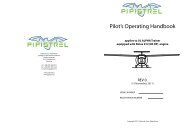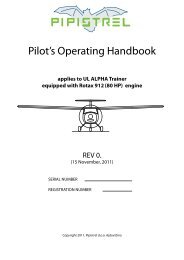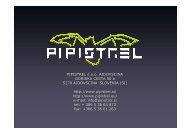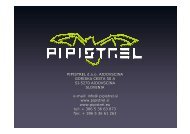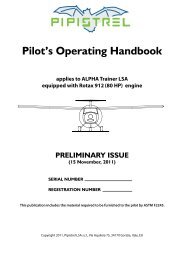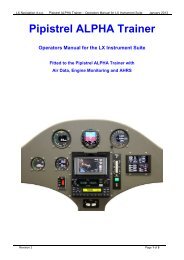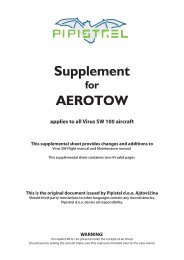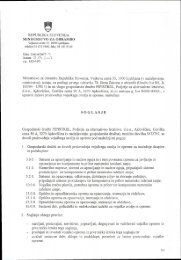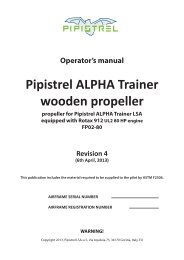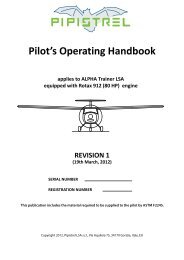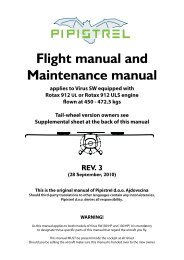Taurus ELECTRO manual 472 ENG.pdf - Pipistrel
Taurus ELECTRO manual 472 ENG.pdf - Pipistrel
Taurus ELECTRO manual 472 ENG.pdf - Pipistrel
Create successful ePaper yourself
Turn your PDF publications into a flip-book with our unique Google optimized e-Paper software.
www.pipistrel.si<br />
TAURUS <strong>ELECTRO</strong> 19<br />
Limitations<br />
REV. 0<br />
WARNING! Should you find water drops on the airframe during preflight<br />
check-up at temperatures close to freezing, you may expect icing to appear in<br />
flight. airbrakes are especially prone to icing under such circumstances. As<br />
water may accumulate underneath the top plate(s), spoilers may freeze to the<br />
wing surface. Should this occur, you will most definitely be unable to extend<br />
spoilers before the ice melts. Therefore, flying under circumstances mentioned<br />
above, it is recommended to extend and retract the spoilers in flight frequently<br />
to prevent its surface freezing to the airframe.<br />
Minimum equipment list<br />
• Airspeed indicator (functional)<br />
• Altimeter (functional)<br />
• Compass (functional)<br />
• Electric System Manager instrument (ESYS-MAN)<br />
• Battery Management System (BMS, functional)<br />
• Parachute rescue system (where required legally)<br />
Other restrictions<br />
Due to flight safety reasons it is forbidden to:<br />
• fly in any rainfall;<br />
• fly during thunderstorm activity;<br />
• fly in a blizzard;<br />
• fly according to instrumental flight rules (IFR) or attempt to fly in zero visibility conditions<br />
(IMC);<br />
• fly when outside air temperature (OAT) reaches 40°C or higher;<br />
• perform any form of aerobatic flying;<br />
• take off and land with flaps retracted or set to negative (-5°) position;<br />
• take off with spoilers extended.<br />
• store the aircraft outside in the rain.<br />
Warning placards<br />
<strong>Taurus</strong> Electro is categorised as an Ultralight aircraft and must wear a<br />
warning placard as such. The placard indicates the<br />
aircraft is not certified according to EASA standards and is therefore flown<br />
completely at pilot’s own risk.





